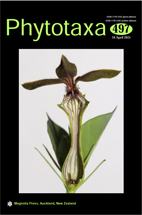Abstract
We describe and illustrate Zamia imbricata and Z. sinuensis, two new species (Zamiaceae, Cycadales) from the Magdalena-Urabá moist forests ecoregion of northern Colombia. The new species appear to belong to the manicata clade, an assemblage of species strongly supported by recent molecular phylogenetic analyses and which shares a set of morphological characters such as hypogeous to semi-hypogeous stems, distinctly toothed leaflets, long peduncles, megasporophylls with relatively flat shields, and diminutive pollen cones containing microsporophylls with a much-reduced fertile section of the lamina. Zamia imbricata, a species from the Middle Magdalena Valley Basin of Caldas, is distinguished from other members of the clade by its planar leaves comprised of diminutive, highly imbricate papyraceous leaflets. Zamia sinuensis, a species from the Sinú River Basin of Córdoba is similar to Z. manicata, from which it is distinguished by the absence of the petiolule and gland-like collar that characterize the latter, and by its strongly undulate leaflets. The two new species are discussed within the context of the manicata clade, and a vegetative key to the clade is provided.

